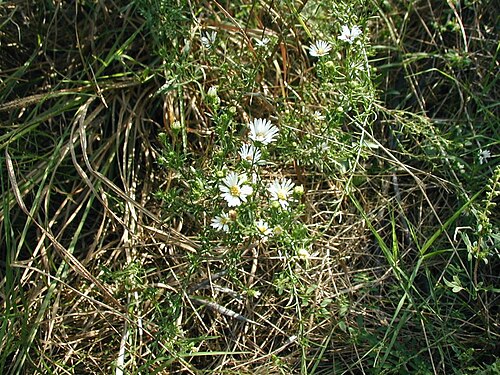Aster (genus)
| Lifespan: | ⌛ | perennial |
|---|
| USDA Zones: | 1 to 11 |
|---|
|
Aster > |
This is the plant information box - for information on light; water; zones; height; etc. If it is mostly empty you can help grow this page by clicking on the edit tab and filling in the blanks!"This is the plant information box - for information on light; water; zones; height; etc. If it is mostly empty you can help grow this page by clicking on the edit tab and filling in the blanks!" is not in the list (If this plant info box on watering; zones; height; etc. is mostly empty you can click on the edit tab and fill in the blanks!) of allowed values for the "Jump in" property.
Aster (syn. Diplopappus Cass.) is a genus of flowering plants in the family Asteraceae. There are roughly 180 species within the genus, all but one being confined to Eurasia.[1] The name Aster comes from the Ancient Greek word ἀστήρ (astér), meaning "star", referring to the shape of the flower head. Many species and a variety of hybrids and varieties are popular as garden plants because of their attractive and colourful flowers. Asters can grow in all hardiness zones.
The genus Aster is now generally restricted to the Old World species, with Aster amellus being the type species of the genus, as well as of the family Asteraceae. The New World species have now been reclassified in the genera Almutaster, Canadanthus, Doellingeria, Eucephalus, Eurybia, Ionactis, Oligoneuron, Oreostemma, Sericocarpus and Symphyotrichum, though all are treated within the tribe Astereae. Regardless of the taxonomic change, all are still widely referred to as "asters" in the horticultural trades. See the List of Aster synonyms for more information.
Cultivation
| Aster calendar? | ||
|---|---|---|
| January: | ||
| February: | sow | |
| March: | sow | |
| April: | divide | |
| May: | transplant | |
| June: | ||
| July: | flowering | |
| August: | flowering | |
| September: | flowering | |
| October: | divide | |
| November: | ||
| December: | ||
| Notes: | ||
Easy to grow?
Propagation
- Division - Divide clumps every two years as growth starts in the spring. Select strong crowns from around the outside of the existing clump and discard the weak central section.
- Seed - Sow either in spring or autumn in a cold frame.
- Cuttings - Take 2 inch long softwood cuttings in spring, use a sandy compost mix, and place in a cold frame to root.
Pests and diseases
The two main diseases which infect asters are rust and powdery mildew, both of which can be avoided by:
- making sure plants are well-spaced to allow for good air circulation; and
- watering plants at the roots so as to avoid the foliage becoming excessively wet.
Rust can be easily identified by the orange pustules which form on the underside of the leaves.
Powdery Mildew appears like a white sooty residue on the upper-side of the leaves, quickly causing defoliation.
Species
- Aster alpinus (Alpine Aster)
- Aster amellus (European Michaelmas Daisy or Italian Aster)
- Aster linosyris (Goldilocks Aster)
- Aster pringlei
- Aster scaber
- Aster sibiricus
- Aster subulatus (Hairless Fleabane)
- Aster tataricus (Tatarian Aster)
- Aster tongolensis
- Aster tripolium (Sea Aster)
Gallery
- 2003 0928 133251AA.JPG
Michaelmas Daisy
References
- w:Aster (genus). Some of the material on this page may be from Wikipedia, under the Creative Commons license.
- Aster (genus) QR Code (Size 50, 100, 200, 500)
- Flora: The Gardener's Bible, by Sean Hogan. Global Book Publishing, 2003. ISBN 0881926248
- American Horticultural Society: A-Z Encyclopedia of Garden Plants, by Christopher Brickell, Judith D. Zuk. 1996. ISBN 0789419432
- Sunset National Garden Book. Sunset Books, Inc., 1997. ISBN 0376038608
External links



